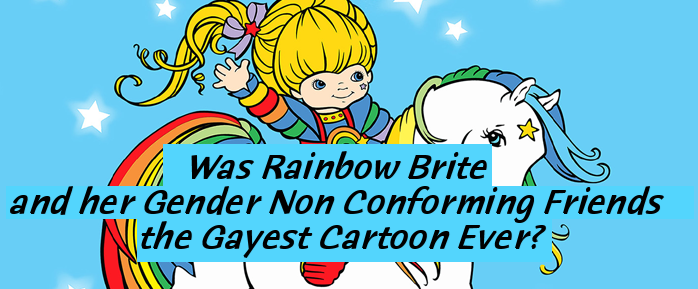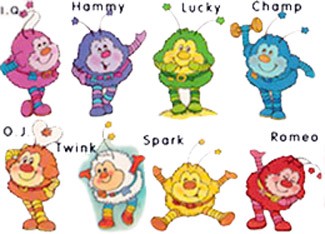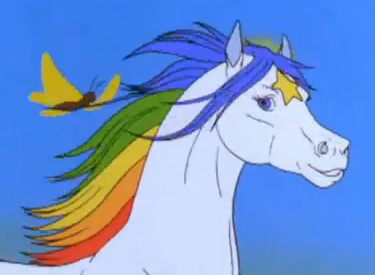
It never occurred to me, but yes. Yes it was!
When I was a kid, I wanted a Rainbow Brite doll more than anything in the world. I was dazzled by her shock yellow hair and daring club kid haute couture fashion.
 Starlite, Rainbow Brite?s trusty and Sassy Steed
Starlite, Rainbow Brite?s trusty and Sassy Steed
She rode around on a magical pony, Starlite, that farted glitter and had a sassy attitude that could rival any drag queen. Her mission throughout her story was to bring color and light to an otherwise bland and bleak world, which had fallen into a a state of disarray due to the growing power of her adversaries, Murky Dismal and his henchman, Lurky. They hate color. They loathe anything different or unique. They embark on a relentless war to rid the world of anything unlike themselves?
Then there was her best friend; Her ?Personal Sprite? aptly named Twink. You see, Twink was this adorable little white puffball with antennae adorned with small golden stars. He was unique, however, in that he had fallen victim to the guile of Murky, and had his bright color stolen from him, thus leaving him white instead of boasting radical colors like his fellow sprites. He had been forcibly converted to a life of the mundane. Regardless of being robbed of his spectacular display of color, Twink was rescued by Rainbow Brite and made her right hand, often left in charge while she was away on her adventures. Twink was the eager-to-please type who wikipedia describes as ?often appearing manic due to his heightened sense of urgency.?

Twink wasn?t the only sprite that made up Rainbow Brite?s little army of cuddly, genderless critters. There was also a variety of others, including Champ, the gym fanatic who was obsessed with working out. Hammy was a campy comedian who had a one-liner for virtually every scenario. Spark was hyper active, always optimistic and the life of the party. O.J., well, they were your typical narcissist, absolutely in love with themself, distracted by their own good looks and loved it when people fawned over them. Romeo was the dashing romantic. They knew how to throw a compliment whether genuine or not, and could talk a snowman out of his carrot if given the opportunity because their charm was simply irresistible. I.Q. was more gentle than their primary colored friends, more effeminate, shy, a little awkward but always well meaning. They preferred to engage in thoughtful, existential conversations rather than go to battle. Lucky Sprite was perpetually jolly but for no particular reason. They were like the best friend you could always tell a secret to and know it would be kept safe in their care- and they also probably crawled under dumpsters to rescue cats if they heard a stray meow.
These Sprites weren?t alone in Rainbow Brite?s war against the forces of oppression and threatened erasure of anything uniquely beautiful or otherwise diverse; Not in the least. Each Sprite, you see, was the companion of what were affectionately known as ?The Color Kids.?
 The Color Kids ? Red Butler, Lala Orange, Canary Yellow, Patty O?Green, Buddy Blue, Indigo, Shy Violet, Tickled Pink, Rainbow Brite, Stormy, Moonglow.
The Color Kids ? Red Butler, Lala Orange, Canary Yellow, Patty O?Green, Buddy Blue, Indigo, Shy Violet, Tickled Pink, Rainbow Brite, Stormy, Moonglow.
Many of The Color Kids, whose very personalities reflected their coordinated colored Sprite, presented with the kind of gender ambiguity that was more reminiscent of 80?s synth bands- not really Saturday Morning Cartoons. While their dress code may have been sometimes binary indicative, their flamboyance and gender ambiguous mannerisms may have left adults confounded. Yet, suffice it to say, the non-conformity of Canary Yellow, who refuses to don the hoop skirt the other girls are famous for, and the drag look- and name- of Tickled Pink left me wondering how I managed to miss such blatant references and deliberate borrowing from LGBT culture in the most amazing ways possible. Also important to mention? Indigo Shy, who far predated Disney?s Princess Jasmine, was showing us that children of ethnic diversity were just as vital- and as magical as their white counterparts. And, she was playing a pivotal role in ensuring the world itself stayed as proudly bright as ever.
Who can say whether or not Rainbow Bright was some genius metaphor for equality, diversity, and the resistance to the demand to conform and comply with socially imposed norms. However, now I can?t watch a single episode without seeing it. The parallels are indisputable, intentional or not. If Rainbow Brite wasn?t a remark on girl power before the Spice Girls sang about it, or Gay Pride, ethnic pride, and the power of unity in the face of relentless adversity coming from positions of power, then it was prophetic at the very least. Simply put; Rainbow Brite was the Queer Icon we needed. We just failed to recognize it.
As it happens, my favorite villains in Rainbow Brite were not the primary duo of Murky Dismal and his easily confused bestie, Lurky? it was the Glitterbots.
Yes, the Glitterbots. A horde of sentient robots under the control of one Sgt. Zombo, a military prison warden who uses the Glitterbots to enslave and control the colorful sprites, and their primary mission was to imprison anyone who dared to depart from standardized forms of bland acceptability codes imposed by social norms.
Ultimately, Rainbow Brite was all about being liberated from ideologists who had a very specific, linear world view which alienated most everyone else. As a result, they were often pursued, persecuted or punished altogether for nothing other than daring being different.
Later reboots of the series clearly saw the gay undertones and went to great lengths to suppress some of the more obvious queer references- even changing the names. In the 2014 revival, Twink was renamed Mr. Glitters- the first time an intentional male pronoun was used to refer to a sprite. The Color Kids kept their iconic looks, but were given a very modern update.
 The 2014 Color Kids Reboot.
The 2014 Color Kids Reboot.


